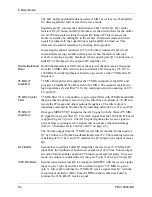
4: 1650 kHz IF Board
4-2
PRC1099A-MS
In upper sideband mode, the DDS on the Synthesizer board generates a BFO
frequency of 1650 kHz that is routed through the high side of the filter. In
lower sideband mode, the DDS generates a BFO of 1647 kHz on the lower
side of the filter passband. The transmit signal consists of the suppressed
carrier (1650 or 1647 kHz) modulated by the transmit audio
The filter output is a modulated 1650 kHz suppressed carrier, single-sideband
signal that is applied to coax connector J3 (1650 I/O) and then routed to the
Mixer board.
4.1.2
Receive Path
In the receive signal path, the 1650 kHz IF board receives the receive signal
from the Mixer board on coax connector J3 (1650 I/O). It is then applied to the
1650 kHz crystal sideband filter.
1650 kHz
Sideband Filter
In receive mode, the 1650 kHz SSB filter provides a 3 kHz passband between
1647 and 1650 kHz that rejects unwanted signals outside the 3 kHz passband
spectrum. The filter passband is symmetrical, enabling the use of one filter for
both upper and lower sideband operations.
In upper sideband operation, the BFO frequency is 1650 kHz on the high side
of the filter passband. In lower sideband mode, the BFO frequency is
1647 kHz on the lower side of the filter passband. The DDS automatically
shifts the BFO by 3 kHz when switching sidebands.
RX IF Amplifier 1
From the 1650 kHz sideband filter, the receive signal is applied to first
1650 kHz IF amplifier Q1. Dual-gate MOSFET Q1 amplifies the receive
signal from the 1650 kHz sideband filter and integrates the AGC signal to
prevent high receive signal levels that may damage components. It is
capacitor-coupled to the filter the amplifier input and has a high input
impedance that provides correct filter matching. The stage gain is controlled
by applying the AGC voltage to gate 2 (Q1 pin 2). The output is
transformer-coupled to the next stage through transformer T3.
RX IF Amplifier 2
Second 1650 kHz IF amplifier Q2 is a fixed-gain common emitter stage with
an unbypassed emitter. The output is transformer-coupled (T4) to the
Audio/Filter board through 3 dB attenuator R10 and R11.
Sidetone
Generator
The 1650 kHz IF system also generates the transmit sidetone for the internal
speaker or headset. The receive IF amplifiers remain switched on in the
transmit mode
listening
to the low level transmitter exciter output. Diode
switch D7 is connected to the drain of Q1 and shorts the drain load of T3. This
prevents overload of the receive IF amplifiers. This method of sidetone
generation provides a complete check of the entire audio, balanced-modulator,
product-detector and 1650 kHz IF system. When coupled with the RF
sidetone gate, the sidetone becomes a powerful diagnostic tool in determining
the complete system performance (BITE).
















































